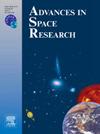Multi-satellite based possible precursory signals detection linked to the 2024 Mw 7.5 Noto Peninsula Japan earthquake
IF 2.8
3区 地球科学
Q2 ASTRONOMY & ASTROPHYSICS
引用次数: 0
Abstract
Satellite-based anomaly detection can provide substantial precursory information linked to impending earthquakes (EQ). The strong EQs are followed by some complex precursory signals both before and after the main shock. For this, different methods and datasets are employed to monitor these disastrous events. In our study, we used the Moderate Resolution Imaging Spectroradiometer (MODIS) satellite to evaluate land surface temperature (LST), the Global Navigation Satellite System (GNSS) to observe total electron content (TEC) variations, Swarm satellites to monitor spatial variations in electron density, and Cosmic satellites were used to measure variations in the vertical profile of electron density to look for the complex precursors of Noto Peninsula Japan EQ of 7.5 Mw (occurred on 1st January 2024). Our objective was to observe both the pre- and post-EQ induced anomalies within 25 days and 10 days of the main shock by integrating the statistical, nonlinear autoregressive network with exogenous inputs (NARX) and continuous wavelet transformation (CWT) methods. We found synchronized and co-located pre-seismic anomalies on December 25 in LST, TEC and electron density. Which was further confirmed using NARX and CWT as well. Additionally, we found some potential post-seismic anomalies. There was an anomalous enhancement in daytime LST, TEC, and electron density on January 2nd with the exception of nighttime LST which showed abrupt increments on the night of the main shock (i.e., January 1st). These findings point towards the strong EQ-induced energy into the atmosphere and ionosphere for more prominent proof of lithosphere-atmosphere–ionosphere coupling (LAIC).
基于多卫星的可能的前兆信号探测与2024年日本诺户半岛7.5 Mw地震有关
基于卫星的异常探测可以提供与即将发生的地震(EQ)相关的大量前兆信息。在主震前后,强烈的eq伴随着一些复杂的前兆信号。为此,采用了不同的方法和数据集来监测这些灾难性事件。在本研究中,我们使用中分辨率成像光谱仪(MODIS)卫星评估地表温度(LST),全球导航卫星系统(GNSS)观测总电子含量(TEC)变化,Swarm卫星监测电子密度的空间变化,利用宇宙卫星测量电子密度垂直剖面的变化,寻找日本诺东半岛EQ为7.5 Mw的复杂前兆(发生于2024年1月1日)。我们的目标是通过整合统计非线性自回归网络与外源输入(NARX)和连续小波变换(CWT)方法,观察主震25天和10天内eq诱发前后的异常。我们发现12月25日LST、TEC和电子密度的震前异常同步且同位。使用NARX和CWT进一步证实了这一点。此外,我们还发现了一些潜在的震后异常。除夜间地表温度在主震夜间(1月1日)出现突变增加外,1月2日白天地表温度、TEC和电子密度均有异常增强。这些发现为岩石圈-大气-电离层耦合(LAIC)提供了更突出的证据,指出了强eq诱导能量进入大气和电离层。
本文章由计算机程序翻译,如有差异,请以英文原文为准。
求助全文
约1分钟内获得全文
求助全文
来源期刊

Advances in Space Research
地学天文-地球科学综合
CiteScore
5.20
自引率
11.50%
发文量
800
审稿时长
5.8 months
期刊介绍:
The COSPAR publication Advances in Space Research (ASR) is an open journal covering all areas of space research including: space studies of the Earth''s surface, meteorology, climate, the Earth-Moon system, planets and small bodies of the solar system, upper atmospheres, ionospheres and magnetospheres of the Earth and planets including reference atmospheres, space plasmas in the solar system, astrophysics from space, materials sciences in space, fundamental physics in space, space debris, space weather, Earth observations of space phenomena, etc.
NB: Please note that manuscripts related to life sciences as related to space are no more accepted for submission to Advances in Space Research. Such manuscripts should now be submitted to the new COSPAR Journal Life Sciences in Space Research (LSSR).
All submissions are reviewed by two scientists in the field. COSPAR is an interdisciplinary scientific organization concerned with the progress of space research on an international scale. Operating under the rules of ICSU, COSPAR ignores political considerations and considers all questions solely from the scientific viewpoint.
 求助内容:
求助内容: 应助结果提醒方式:
应助结果提醒方式:


